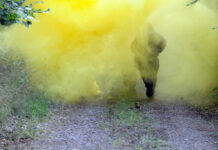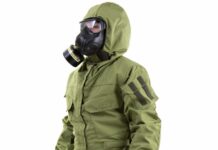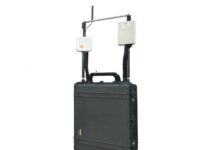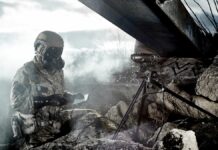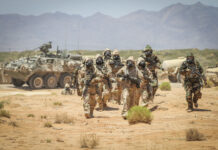It has long been assumed that chemical, biological or radiological/nuclear (CBRN) threats pose a major problem for the military and civilian response forces. The main reason for this assumption is that vehicles can be contaminated with liquid or solid CBRN materials.
Some threat materials, such as persistent nerve agents, sulphur mustard, anthrax spores, and many radioactive isotopes, can remain potent threats for days or weeks after an attack or incident.
Vehicle Contamination
Vehicle contamination becomes a key concern in military operations. When chemical weapons first made their military debut in 1915, warfare was largely an affair dominated by infantry foot soldiers, and artillery was towed by horses. Warfare in the modern era relies heavily on armoured and unarmoured vehicles. Artillery systems are towed by vehicles or are self-propelled. Vast logistical trains of trucks support modern armies in the field. Aircraft have numerous military uses. All of these are vulnerable to contamination.
Various surfaces and materials on vehicles could absorb liquids and actually make them more persistent than they would normally be in the ambient environment. Persistent contamination could cause injuries long after an attack, as substances desorb out of vehicle exteriors or interiors. Vehicle crews and passengers could be forced to wear cumbersome protective clothing, thus degrading their operational capability. Loss in operational capacity due to the operational necessity of wearing CBRN protection is a strong motivator in military decontamination planning. No artillery crew wants to spend hours or days in full kit while conducting fire missions.

Military commanders must make critical decisions when vehicles get contaminated. Do they take vehicles and their crews out of combat operations for decontamination? Or do they continue to fight, and assume the risks of diminished capability, injuries to crew and passengers, and spread of contamination? The cold hard logic of military operations is clear and well-founded on studies of the history of chemical warfare. Usually, the best course of action is to continue the conventional fight and worry about decontamination later. Any serious study of modern warfare shows that small arms and artillery are, statistically, far more lethal than chemical weapons, even against troops with little protection. Moreover, in some of the few battles in history where chemical weapons played a decisive role showed that it was conventional follow-up to chemical attacks that made the important difference. Therefore, decontamination, as an operational imperative, needs to take second billing to conventional warfighting.
Deferring decontamination does pose its own risks. Contaminated vehicles could spread contamination from the site of an attack, thus contaminating roads, airfields or supply routes. Vehicle crew or passengers could inadvertently transfer contamination when they leave a vehicle. Driving to a designated decontamination site is likely to spread contamination. The decision as to where and when to conduct decontamination needs to account for the operational imperatives of ongoing combat operations, while also understanding that decontamination is best done quickly and nearby, rather than much later and far away.
CBRN vehicle contamination was long relegated to the military as a defence issue. However, civil emergency services may be vulnerable to vehicle contamination as well. Fire services and ambulance services rely heavily on specialist vehicles. Terrorist incidents could cause contamination of emergency vehicles. Police vehicles, fire engines, and ambulances could be taken out of service at precisely the time they are needed most. Only in recent years has the reality of CBRN contamination of vehicles been realised among civil responders. Small amounts of residual contamination were found or suspected in a number of vehicles involved in response in Salisbury in 2018 after the Novichok incidents.
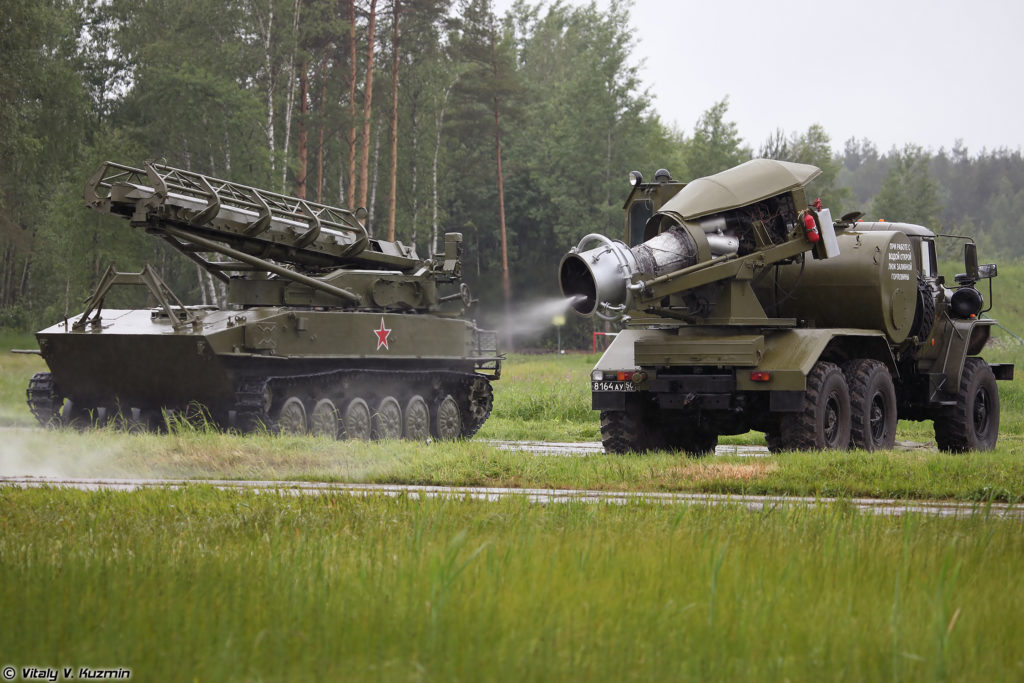
How Clean is Clean Enough?
Every discussion of decontamination needs to ask the question – when do you stop decontaminating? As discussed in previous articles in this journal, there are not really many useful standards as to how clean is clean enough. A standard of zero threat is not realistic as there is no way of proving a negative. Every conceivable detection and identification method has a minimum threshold of detection, so even the most thorough decontamination methods may leave some residue of hazards. As a practical matter, until detection methods improve and standards of cleanliness get agreed upon, the only reasonable course of action is to decontaminate to levels set by the available detection methods. However, improvements in the sensitivity of detection will likely provoke requirements to decontaminate to a higher standard. Efforts to provide rational standards for vehicle decontamination are necessary, but are proceeding at a glacial pace. It is a bit unsatisfactory that there is an ISO standard for a cargo container, but not for the decontamination system inside the container.
Patterns of Contamination
Contamination can be caused by liquids or solids. However, the various types of substances that can cause contamination are too many to list and too diverse to attempt to describe in this article. More importantly, the geometry and distribution of contamination on vehicles is a useful concept. Gross contamination all over a vehicle is clearly a major problem, but spot contamination of one or two particular patches is a lesser problem. In theory, it is much faster to decontaminate just one bit of a vehicle that decontaminating the entire vehicle. However, knowing the distribution of decontamination requires detection equipment and a lot of time and labour. Surveying a tank at 1 cm per second (the current state of the art) will take a lot longer than decontaminating the entire vehicle. Improvements in detection would greatly help in improving the efficiency of decontamination.
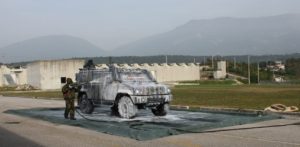
Exterior contamination of vehicle surfaces is one type of contamination, and it can be addressed in particular ways. Interior contamination, with softer and more porous surfaces (such as seats and individual equipment) may be a more pernicious problem than external contamination on hard surfaces like glass, paint, and armour. Finally, even more problematic is the contamination of sensitive equipment like electronics or medical equipment. Decontaminating such items in a way that still leaves them functioning as intended is tricky. Typical water-based approaches do not work on electronics. This is especially critical as the vehicles that are the highest priority for decontamination will likely be the ones with the most electronics.
Approaches to Decontamination
There are numerous technical and operational approaches to vehicle decontamination. A classic approach to decontamination is neutralisation. Some authorities call this detoxification. This approach uses chemical substances, often in solution with water, to react with chemical or biological agents on a vehicle. The ionising radiation emitted by radiological particles is not inactivated by chemistry, so these methods apply only to chemical and biological contaminants. A wide variety of chemical substances have been used over the years for these purposes. Many are chlorine-based, such as hypochlorite bleaches. Acids and peroxides have often been used as well. In the USA there is interesting work being done on specific enzymes to increase the vulnerability of specific categories of chemical agent to reaction with water. In general, the various neutralisation solutions often require removal after use, generally by rinsing with water.

Another approach is removal. Decontamination by removal generally involves water, often with soaps or detergents, which can be generic or proprietary. Full decontamination of large combat systems like tanks can take hundreds of gallons of water per vehicle and an extensive amount of labour. Decontamination by removal may be aided by soaps, detergents, surfactants, chelating agents and other such products. Thick, greasy, or oily contaminants, such as mustard or VX, may require scrubbing to come off a vehicle. Decontamination of a company or battalion of combat vehicles can easily tie up dozens of specialists and take many tonnes of water. Indeed, water logistics are often a critical component of CBRN decontamination plans, and some environments, such as deserts, will have limited availability of water for decontamination.
In practice, there is significant overlap between neutralisation and removal techniques. Warm soapy water is, in effect, both a removal agent and a neutralisation agent for many types of threats. Many chemical warfare agents react with water over time. A large number of commercially available neutralisation chemicals are, in effect, cocktails that include detergents and surfactants and such to help removal as well as neutralisation.
It should be noted that some approaches in the past have used other creative methods than water for removal. Some approached have utilised large air blowers, even dismounted jet engines. The Soviet Union developed a jet engine mounted on a truck, called the TMS-65. It is still occasionally seen in Russia and other former Soviet states. Such an approach may work, but stands the risk of creating a significant downwind vapour hazard by volatilising persistent chemicals. In the past, even more creative approaches had been tried. In the early 1990s, the US Army experimented with chlorinated fluorocarbons as a removal agent, but both cost and environmental issues doomed this idea.
Although it is not something that the CBRN decontamination industry wants people to talk about, there are alternatives to removal and neutralization that are, in essence, free. Ageing and weathering are viable alternatives. Vehicles that are not immediately needed for operations can be set aside in a safe and secure place, to let nature take its course. Warm temperatures, natural precipitation, wind, and humidity will degrade most contaminants over time. The passage of time will allow for natural decay of many radioisotopes with short half-lives. For example, a tank with contamination from the nerve agent Sarin, famously non-persistent, may be mostly Sarin-free in a day in hot weather.
Vehicles that are heavily contaminated but inexpensive and/or easy to replace could be abandoned. While nobody particularly advocates this as normal practice, if a police car or ambulance can be replaced for less than the cost of a thorough decontamination, such vehicles may end up in landfills. This was indeed the case in the Salisbury “Novichok” incident as several emergency services vehicles were disposed of as their decontamination was considered less economically viable than replacement.
The Decontamination Market Segment
Various aspects of decontamination have been addressed in previous issues of this magazine in recent years, and it should be noted that change and progress in this segment has occurred in what can only be described as a sedate manner. As a segment of the defence industry, vehicle decontamination often suffers as a relative backwater, even within the narrow CBRN sector of the overall defence market. Research and development in this area is comparatively under-funded in recent decades. Major system buys are rare. Heavy decontamination equipment often gets very little use in peacetime, so it wears out slowly if maintained well. Technology has not made sufficient step-changes to warrant major refitting of military decontamination units. Indeed, in some corners of the US Army, vehicle decontamination equipment from the 1980s still lingers in operational inventories.
CBRN decontamination products are largely divided into systems and chemicals. Systems involve the various apparatus for spraying, fumigating, or otherwise applying neutralising materials or detergents. Decontamination chemicals are various powders, foams, and liquids designed to help decontamination by neutralisation and/or removal. In both categories, specialty equipment competes with generic equivalents. A fire engine can decontaminate a tank. Generic laundry soap can be used to decontaminate an artillery piece. Indeed, the tacit competition between high cost specialty items and low-cost generics is one of the reasons that decontamination is a commercially challenging sub-sector of the CBRN industry.
In general, the same market players are active in this field as identified in this publication in 2016. In the European space, Kärcher (GE) and OWR (GE) continue as market leaders in many markets beyond their own domestic market space. Both Kärcher and OWR provide both equipment (sprayers of all sizes) and chemistry (solutions for removal and neutralisation) for every major CBRN vehicle decontamination requirement. Bioquell (UK) is not a major player in the traditional military vehicle decontamination market, but its peroxide fumigation technology may have extensive use for sensitive equipment and vehicle interiors, given the opportunity. NBC Sys (France) and Hispano Vema (Spain) continue to make products mostly for their own respective domestic markets.
Cristanini (Italy) continues to hold a prize place among decontamination companies, with successful marketing efforts in both military and civil emergency response agencies in dozens of countries. They have two systems of note that represent useful capabilities in vehicle decontamination. The Cristanini Mobile Decontamination Arch is, in effect, the equivalent of a mobile car wash. It is modular and can be assembled in various sizes for different vehicles. It can apply water, or generic cleansing agents, or Cristanini’s own decontamination chemicals. A single arch can use up to 59 litres of water per minute. Thoroughness of decontamination can be modulated by the speed at which vehicles transit through the arch. Several can be set up in series, with one arch applying decontamination solutions from every angle and one or more arches further on to rinse off the vehicles and any remaining residual contamination.
Cristanini’s plant in Verona has other useful additions in the vehicle decontamination arena. The impressive LVD-X system uses hydroxide radicals to fumigate large volumes of confined space. This technology can decontaminate spaces like the interiors of vehicles or aircraft, and it is far less disruptive to communications, avionics, or medical equipment. Finally, their SX-34 is a useful way to decontaminate electronics or other sensitive items, filling yet another gap in decontamination technology. Cristanini is certainly one of the companies in this sector to watch.
It important to not overlook the Czechs. They inherited much of the Warsaw Pact’s expertise in CBRN operations and continue to provide valuable service in this space. VOP Defence, near Brno, makes several vehicle decontamination systems, including the MDA Small Decontamination Vehicle. Their Linka-08 is configured in an ISO container and can set up a “car wash” style decontamination lane. The Czechs specialise in providing CBRN capability to NATO, so these systems will get seen a fair bit.
In the US CBRN market space, which traditionally accounts for about half of worldwide CBRN expenditures, 18 years of land wars in places like Iraq and Afghanistan without vehicle decontamination requirements has slowed developments and procurements. It has been 13 fiscal years since the roll-out of the modest M26 Joint Service Transportable Decontaminating System Small Scale (JSTDS-SS). Made by DRS Technologies (USA), this is a capable system, but for something that has been around for over a decade, various US Army documents claiming it as “new” begin to look a bit tired.
Much of the development in the North American market has been the transition of US government technology into the private sector. Two rival decontamination chemical solutions are now on the US and world market. So-called “Sandia Foam”, first developed by the US Department of Energy’s Sandia National Laboratory, is now licenced for commercial exploitation by private companies. This foam dates from the late 1990s. Intelagard (USA) markets it as “DF-200” and provides numerous options for applying it. Others sell essentially the same product under licence, generally to North American customers.
The other major American product of note is called Dahlgren Decontamination Solution. It originated from research starting in 1999 at the US Navy’s research centre in Dahlgren, Viriginia. So-called “Dahlgren” solution, a set of three chemicals which are meant to be dissolved in water, is highly effective at decontaminating chemical and biological agents. It is now licenced to First Line Technologies, a Virginia-based company. This technology won a Federal government prize for “Excellence in Technology Transfer” in 2018. Both Sandia foam and Dahlgren solution are interesting as they originated outside of the US Army, which is normally the locus of developments in CBRN defence in the USA. Whether this reflects a lack of effort or priority by the Army’s own labs is uncertain.
Canada should not be overlooked. DEW Engineering and Development, based in Ottawa, has developed a combined personnel and vehicle decontamination system. This has been done in partnership with the French firm NBC Sys. This relatively recent system can decontaminate up to four armoured vehicles an hour. At least six systems were procured by the Canadian military, and the Canadian government retains options to buy several more.
Vehicle decontamination remains largely a hypothetical exercise for the world’s militaries as it has been many decades since CBRN contamination of major vehicle systems was a practical reality. It seems likely that military support to civilian emergency services is a more likely operational scenario for military decontamination systems in this current era. Generally, progress in this area lags behind protection and detection, with only a few rare exceptions. Prospects for change will rely on one of two developments. A military CBRN operation will show where the shortfalls in decontamination are and may provoke change in this sector. Alternatively, a radical change in detection of contamination on surfaces will provide more clarity on what constitutes adequate decontamination, thus perhaps driving more innovation in this sector.
Dan Kaszeta is Managing Director at Strongpoint Security Ltd. and a regular contributor to ESD.



